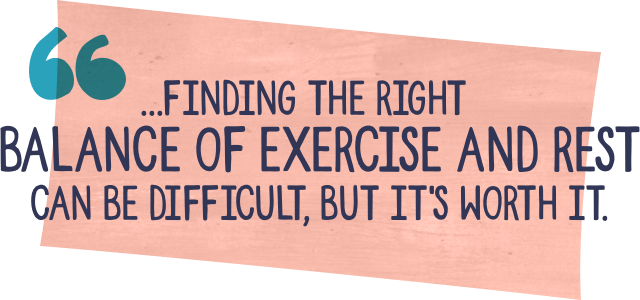Lupus Balance Between Exercise and Rest
If I hear one more person tell me to move when I am in pain, I will scream! How many of you have said this to yourself? I know I have because it seems everyone thinks it is so easy. We all know it isn’t, and it takes time to balance pain, exercise, and rest.
Lupus can be difficult to manage, and there is no one-size-fits-all solution. However, maintaining a balance of exercise and rest is an important part of managing the disease. Finding the right balance of exercise and rest can be near impossible, but trying to maintain a healthy lifestyle is important. Exercise and rest are both important parts of managing lupus.
I have found that balance is especially important because lupus can cause so much fatigue and joint pain. It makes it difficult to stay active. However, exercise is crucial, as it can help to reduce inflammation, improve muscle strength, and maintain joint function. By staying active and exercising regularly, I can keep my lupus under control and live a relatively normal life.

Exercising with lupus
Exercise plays an important role in maintaining my physical and mental health. It helps reduce fatigue, improve joint pain and stiffness, improve circulation, and promote well-being. However, I have had to learn how important it is not to overdo it. Once again, Balance is key.
It helps to find an activity level that works for you as you battle lupus. You may need to experiment to find what works best. I often have to start over and over after flares with low-impact activities and build up to more strenuous activities as I am able.
Types of exercise
Many different types of exercise can be helpful as you battle lupus. Low-impact activities like walking, yoga and tai chi are good options. I have learned that balance exercises, like Pilates, help improve balance and coordination. I have also found water aerobics is efficient in getting exercise while having fun. It also has a very low impact on your body, making exercise less stressful.
I always try to start slowly and build up gradually. It is so important to me to avoid any activities that could worsen my symptoms. When feeling particularly fatigued, I make it a point to listen to my body and take a break. I have learned the hard way that overdoing it can lead to problems.
Exercise can improve your mood and lift your spirit. Exercise can help to release endorphins. Endorphins are feel-good chemicals that are released by the brain. They can help to reduce pain, enhance energy and promote better sleep.
Resting with lupus
Rest is an important part of any fitness plan, especially when dealing with lupus. It allows the body to heal and repair after strenuous activity. At the same time, too much rest can lead to stiffness and weakness. Finding the right balance of rest and activity is essential for optimal results.
Featured Forum
View all responsesToo often, it is difficult to rest in between the pain. Sometimes resting is harder to achieve than the exercise itself. As I walk on this lupus journey, I learn more daily about the importance of resting.
4 types of rest
While dealing with lupus, for me, rest is most important. I try to rest in 4 ways daily to keep myself balanced.
- Physical rest – Because letting my body heal is important. This means getting enough sleep, eating a healthy diet, and exercising regularly.
- Mental rest – to help reduce stress and give my mind a break. Most times, this includes activities like meditation, reading, and spending time in nature.
- Emotional rest – This is needed to deal with the feelings that come with lupus. Usually, this will include therapy, journaling, and talking to friends and family.
- Social rest – helps me stay connected with other people. Ultimately this includes things like attending support groups, going out with friends, and volunteering.
Balance between rest and exercise
In conclusion, finding the right balance of exercise and rest can be difficult, but it's worth it. Exercise, with its many physical and mental benefits, makes you feel good. And when you're feeling good, it's easier to stick to your lupus treatment plan. Balancing rest and relaxation are just as important. As we battle lupus, we often have difficulty sleeping, which can further contribute to fatigue. Finding ways to relax and unwind to help with lupus symptoms is paramount.
Overall, exercise and rest are important for those fighting lupus. By finding a balance between the 2, you can help to improve your life on your lupus walk dramatically. So, find what works for you and give yourself the time and space to heal. Don’t forget to talk to your doctor about what types of exercise and how much rest is right for you. Everyone is different, and finding a balance that works for you is important.

Join the conversation